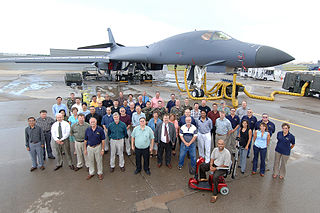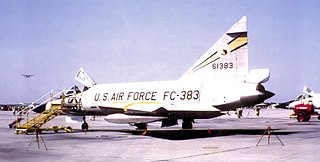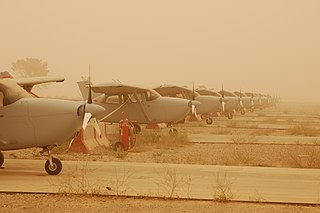
The Southeast Air Defense Sector (SEADS), was a unit of the US Air Force located at Tyndall Air Force Base near Panama City, Florida. It provided air defense and surveillance of the southeastern region of the US. SEADS closed in winter 2005, giving up surveillance and control of their airspace to the Eastern Air Defense Sector (EADS) and the former Northeast Air Defense Sector (NEADS).

Aerospace Defense Command was a major command of the United States Air Force, responsible for air defense of the continental United States. It was activated in 1968 and disbanded in 1980. Its predecessor, Air Defense Command, was established in 1946, briefly inactivated in 1950, reactivated in 1951, and then redesignated Aerospace rather than Air in 1968. Its mission was to provide air defense of the Continental United States (CONUS). It directly controlled all active measures, and was tasked to coordinate all passive means of air defense.

The 9th Space Division is an inactive United States Air Force organization. Its last assignment was with Air Force Space Command, being stationed at Patrick Air Force Base, Florida. It was inactivated on 1 October 1991.

The 327th Aircraft Sustainment Wing is an inactive wing of the United States Air Force last based at Tinker Air Force Base, Oklahoma. It was last assigned to Air Force Materiel Command's Oklahoma City Air Logistics Center.

The 5th Flying Training Squadron is part of the United States Air Force's Air Force Reserve Command serving as a reserve associate squadron operating with the 71st Flying Training Wing at Vance Air Force Base, Oklahoma. It operates the Raytheon T-1 Jayhawk, Northrop T-38C Talon, and Beechcraft T-6A Texan II aircraft conducting flight training in support of the 71st Operations Group.

The 498th Fighter-Interceptor Squadron is an inactive United States Air Force unit. Its last assignment was with Air Defense Command stationed at Hamilton Air Force Base, California. It was inactivated on 30 September 1968.

The 331st Fighter-Interceptor Squadron is an inactive United States Air Force unit. Its last assignment was with Air Defense Command at Webb Air Force Base, Texas, where it was inactivated on 1 March 1967.

The 539th Fighter-Interceptor Squadron is an inactive United States Air Force unit. Its last assignment was with the 26th Air Division at McGuire Air Force Base, New Jersey, where it was inactivated on 31 August 1967.

The 456th Fighter-Interceptor Squadron is an inactive United States Air Force unit. Its last assignment was with the Air Defense Command San Francisco Air Defense Sector stationed at Oxnard Air Force Base, California. It was inactivated on 18 July 1968.

The 15th Test and Evaluation Squadron is a United States Air Force unit, stationed at Eglin Air Force Base, Florida and assigned to the 753rd Test and Evaluation Group. It was first activated in the expansion of the United States military forces prior to World War II as the 15th Pursuit Squadron. It moved to Panama in 1942, where it participated in the defense of the Panama Canal. It returned to the United States, where it was a Replacement Training Unit for fighter pilots until 1944, when it was disbanded as the 15th Fighter Squadron in a reorganization of Army Air Forces training units in 1944

The 98th Fighter-Interceptor Squadron is an inactive United States Air Force unit. Its last assignment was with the New York Air Defense Sector of Air Defense Command stationed at Suffolk County Air Force Base, New York, where it was inactivated on 30 September 1968.

The 325th Fighter-Interceptor Squadron is an inactive United States Air Force unit, last assigned to Air Defense Command at Truax Field, Wisconsin, where it was inactivated on 25 June 1966.

The 83d Fighter Weapons Squadron is a United States Air Force unit, assigned to the 53rd Weapons Evaluation Group and stationed at Tyndall Air Force Base, Florida.

The 326th Fighter-Interceptor Squadron is an inactive United States Air Force unit. Its last assignment was with the 328th Fighter Wing at Richards-Gebaur Air Force Base, Missouri, where it was inactivated on 2 January 1967.
Thomasville Air Force Station is a closed United States Air Force General Surveillance Radar station. It is located 1.9 miles (3.1 km) north-northwest of Thomasville, Alabama. It was closed in 1969.

The 482d Fighter-Interceptor Squadron is an inactive United States Air Force unit. Its last assignment was with Montgomery Air Defense Sector at Homestead Air Force Base, Florida in 1969. During World War II the squadron was a replacement training unit until disbanded in 1944 when the Army Air Forces converted training units to Army Air Force Base Units. It was reconstituted in 1955 and served as a fighter interceptor squadron until 1969.

The 438th Fighter-Interceptor Squadron is an inactive United States Air Force unit. Its last assignment was with the 35th Air Division at Griffiss Air Force Base, New York, where it was inactivated on 30 September 1968. The squadron was first activated as the 438th Fighter Squadron during World War II. It served as an Replacement Training Unit until the spring of 1944, when it was disbanded in a general reorganization of Army Air Forces training units. It was reactivated in 1953 as an air defense unit and served in that role until inactivated.

The 437th Fighter-Interceptor Squadron is an inactive United States Air Force unit. Its last assignment was with 414th Fighter Group at Oxnard Air Force Base, California, where it was inactivated on 30 September 1969.

The 13th Fighter-Interceptor Squadron is an inactive United States Air Force unit. Its last assignment was with the Minot Air Defense Sector, stationed at Glasgow Air Force Base, Montana where it was inactivated on 30 June 1968.

The 337th Aeronautical Systems Group is an inactive United States Air Force unit. Its last assignment was with the Aeronautical Systems Center of Air Force Materiel Command at Wright Patterson Air Force Base, Ohio, where it was inactivated in 2008.
























